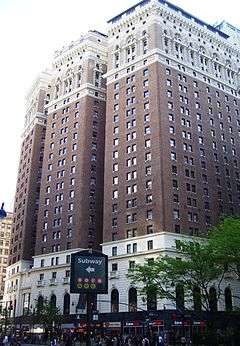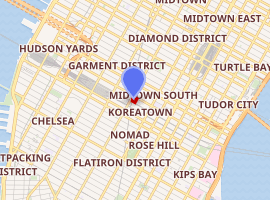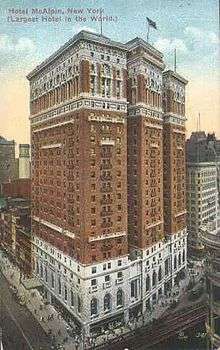Hotel McAlpin
The Hotel McAlpin is a historic hotel building on Herald Square, at the corner of Broadway and 34th Street in Manhattan, New York City. It currently operates as an apartment building known as Herald Towers.
| Herald Towers | |
|---|---|
 Herald Towers, 2011 | |

| |
| Former names | Hotel McAlpin |
| General information | |
| Location | 1282-1300 Broadway Manhattan, New York City, New York |
| Construction started | 1911 |
| Completed | 1912 |
| Height | 308 feet (94 m) |
| Technical details | |
| Floor count | 25 |
| Design and construction | |
| Architect | Frank Mills Andrews |
| References | |
| [1] | |

History
The Hotel McAlpin was constructed in 1912 by General Edwin A. McAlpin, son of David Hunter McAlpin. When opened it was the largest hotel in the world. The hotel was designed by the noted architect Frank Mills Andrews (1867–1948). Andrews also was president of the Greeley Square Hotel Company which first operated the hotel.[2]
Construction of the Hotel McAlpin neared completion by the end of 1912 so that the hotel had an open house on 29 December. The largest hotel in the world at the time, The New York Times commented that it was so tall at 25 stories that it “seems isolated from other buildings”[3] Boasting a staff of 1,500, the hotel could accommodate 2,500 guests. It was built at a cost of $13.5 million ($358 million today[4]). The top floor had a Turkish bath and there were two gender-specific floors; women checking into the hotel could reserve a room on the women's only floor and bypass the lobby and check in directly at their own floor. One floor, dubbed the “sleepy 16th” was designed for night workers so that it was kept quiet during the day. It also hosted a travel agency.[5]
The hotel underwent an expansion half a decade later. The owners had purchased an additional 50 feet of frontage on 34th street two years early and proceeded to dismantle those properties. The new addition was the same height as the original 25-story building, and was expected to provide an additional 200 rooms, four more elevators, and a large ballroom.[6] A major refurbishment costing $2.1 million was completed in 1928 refreshing the rooms, installing modern bathrooms and updating the elevators.[7]
The McAlpin family sold the hotel in 1938 to Jamlee Hotels, headed by Joseph Levy, president of Crawford Cloths, a prominent real estate investor in New York for $5,400,000. Jamlee reportedly invested an additional $1,760,000 in renovations. During the Jamlee ownership, the hotel was managed by the Knott Hotel Chain until 1952 when management was taken over by Tisch.[8] On October 15, 1954, Jamlee sold the hotel to Sheraton Hotels for $9,000,000 and it was renamed the Sheraton-McAlpin. Sheraton completely renovated the hotel five years later and renamed it the Sheraton-Atlantic Hotel on October 8, 1959.[9] Sheraton sold the hotel to the investing partnership of Sol Goldman and Alexander DiLorenzo on July 28, 1968[10] for $7.5 million and it reverted to the Hotel McAlpin name. [11] Sheraton briefly reacquired the hotel in 1976, through a default by the buyers, and quickly sold it to developer William Zeckendorf, Jr. who converted the McAlpin to 700 rental apartments.[11]
During the housing bubble, the building attempted to convert to condominiums but ultimately failed.[12] It is currently a rental building known as Herald Towers.[13]
Notable events
On Christmas Eve 1916, Harry K. Thaw, former husband of Evelyn Nesbit and the murderer of Stanford White, attacked 19-year-old Fred Gump, Jr. in a large suite on the 18th Floor. Thaw had enticed Gump to New York with a promise of a job but instead sexually assaulted him and beat him repeatedly with a stocky whip until he was covered in blood. According to the New York Times, Thaw had rented two rooms on either side of his suite to muffle the screams. The next day, Thaw's bodyguard took Gump to the aquarium and zoo before the boy managed to escape.[14] Gump's father sued Thaw for $650,000 for the "gross indignities" that his son suffered.[15] It was eventually settled out of court.
In 1920, The McAlpin hosted what may have been the first broadcast from a New York hotel. The Army Signal Corps arranged the broadcast by singer Luisa Tetrazzini from her room in the hotel. Tetrazzini (1871-1940) was an Italian lyric coloratura soprano who had an enormous popularity in America from the 1900s-1920s. Several dishes were named after her, the origin of the “Tetrazzini” dish is unknown, but several newspaper articles attribute it to a famous chef (not named) in New York City. Luisa Tetrazzini supposedly gave her recipe for “Spaghetti Tetrazzini” to Louis Paquet, Executive Chef of the McAlpin Hotel on Herald Square in New York City. Luisa Tetrazzini would subsequently take cooking lessons from Chef Louis Paquet of the McAlpin Hotel on how to make his Spaghetti Tetrazzini before embarking on one of her concert tours.
In 1922, the McAlpin became one of the first hotels to link ship-to-shore radios into their phone system.[16] The hotel would later be the first home of, and give the call letters to, radio station WMCA in 1925.
In 1947, Jackie Robinson, a resident living on the 11th floor, received the phone call here from the Brooklyn Dodgers that would change America forever by being the first African American player in Major League Baseball.
From 1969 to 1975 (excepting 1973), the hotel hosted the U.S. National High School Chess Championship, organized by prolific chess promoter Bill Goichberg.
Marine Grill
The hotel's Marine Grill was considered one of the more unusual interiors in the city of New York due to "an expansive grotto of polychrome terra cotta designed by the artist Frederick Dana Marsh."[17] The building owner had closed the restaurant and historic preservationists were concerned with the future of the artwork. Their worst fears were realized when Susan Tunick, president of the non-profit group Friends of Terra Cotta, saw dumpsters outside the hotel filled with fragments from the murals. Rescue efforts were eventually successful when the murals were reassembled under the oversight of the MTA Arts for Transit Program at the William Street entrance to the Fulton Street subway station.
See also
References
- "Herald Towers Apartments". Emporis.
- "FM Andrews Dies, a Noted Architect". The New York Times. 3 September 1948. Retrieved 2008-09-01.
- "Flock to Inspect the Biggest Hotel" (PDF). The New York Times. 30 December 1912. Retrieved 2008-09-01.
- Federal Reserve Bank of Minneapolis. "Consumer Price Index (estimate) 1800–". Retrieved January 1, 2020.
- "Where are you going to spend your summer?". The Independent. Jul 13, 1914. Retrieved August 21, 2012.
- "Hotel McAlpin Addition" (PDF). The New York Times. 18 March 1917. Retrieved 2008-09-01.
- "Hotel McAlpin Changes Completed". The New York Times. 21 December 1928. Retrieved 2008-09-01.
- "$9,000,000 is Paid for the M'Alpin". The New York Times. 15 October 1954. Retrieved 2009-01-07.
- "Redone McAlpin Hotel Now Sheraton-Atlantic". The New York Times. Retrieved 21 September 2018.
- "The Courier-Journal from Louisville, Kentucky on July 28, 1968 · Page 83". Newspapers.com. Retrieved 21 September 2018.
- Tomasson, Robert E. "Zeckendorf Negotiating to Buy the McAlpin". The New York Times. Retrieved 21 September 2018.
- Barbanel, Josh (11 June 2006). "Condo Sales with a Catch". The New York Times. Retrieved 2008-09-01.
- Concept. "Home - Herald Towers". Herald Towers. Retrieved 21 September 2018.
- "Whipping of Boy Stars Hunt for Harry K Thaw" (PDF). The New York Times. 10 January 1917. Retrieved 2014-05-19.
- "Suit is Initiated Against Harry K Thaw". The Spartanburg Herald. 17 October 1917. Retrieved 2014-05-19.
- Jaker, Bill (1998). The Airwaves of New York. McFarland & Company. p. 119. ISBN 0-7864-0343-8. Retrieved 22 June 2009.
- Grey, Christophaer (23 July 1989). "Streetscapes:The McAlpin Marine Grill; The Fate of a Polychrome Grotto Hangs in Balance". The New York Times. Retrieved 2008-09-01.
| Wikimedia Commons has media related to Herald Towers. |